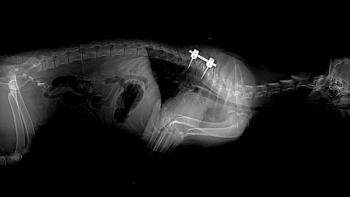
- dvm360 September 2021
- Volume 52
Common canine spinal disease simplified
Although the spinal cord choreographs everything a dog does, it is a delicate neural pipeline and vulnerable to common issues that can be mechanical, vascular, infectious, or degenerative.
When managing “spinal” disease, the first step is ruling out an imposter such as a cruciate tear, immune-mediated polyarthritis (IMPA), and metabolic and vascular issues that produce weakness (ie, internal bleeding). “When something can’t walk, we need to first ask whether it is truly neurological and then, number two, if it is like this because of a problem in the brain or in the spine or if it is neuromuscular,” explained Michelle Carnes, DVM, MS, DACVIM, medical director at Specialists in Companion Animal Neurology in Naples, Florida.
Localize and characterize the lesion
The next step is localizing the lesion into one of the 3 main anatomic districts: cervical; T3-L3; and L4>caudad. This neurologic examination also assesses motor function, proprioception, spinal reflexes, and deep pain perception.
The lesion is likely high cervical if the motor and/or proprioception are abnormal and withdrawal reflex is normal in all 4 limbs. However, if the withdrawal reflex is decreased/absent in the front limbs but normal in the hind limbs, the lesion is likely low cervical. For T3-L3 and lower lumbar lesions, the thoracic limbs are unaffected but the hind limbs have abnormal withdrawal reflexes. If withdrawal reflexes are decreased or absent in all 4 limbs, the problem is neuromuscular, Carnes explained: “Make sure it’s spinal, because neuromuscular takes us on a very different pathway from a spinal cord problem.”
The presence of spinal pain leads down a different path than its absence. For example, if pain is present, think spinal fracture, extradural neoplasia, or acute intervertebral disc disease (IVDD). A nonpainful dog, on the other hand, could be experiencing chronic IVDD, intradural neoplasia, fibrocartilaginous embolism (FCE), or degenerative myelopathy.
Intervertebral disc herniation
IVDD is the most common cause of myelopathy and back pain in dogs. Chondrodystrophic breeds are predisposed, often presenting between 3 and 6 years of age.
Three types of IVDD exist:
- Hansen Type I – acute extrusion of the nucleus pulposus from the annulus fibrosus
- Hansen Type II – chronic bulging of the annulus fibrosus
- Hansen Type III – acute, high-velocity, noncompressive extrusion of the nucleus pulposus
- secondary to sudden tear in the annulus fibrosus resulting from spinal trauma
The clinical signs—which vary with the spinal level of the lesion—are back pain, proprioceptive deficits, and paresis/paralysis. The absence of deep pain (assessed by compressing the digits) is the primary negative prognostic factor and signals the need to act fast. “The sooner the better,” Carnes said. “You’re getting secondary injury the longer that compression is there.”
To relieve compression and prevent spinal cord necrosis—which, in 10% of patients lacking deep pain, can culminate in the irreversible liquefactive condition known as myelomalacia—surgery may be necessary. Besides the absence of deep pain, the chief indications for surgery are nonambulatory paraplegia or paresis, recurring paresis, unrelenting spinal pain, or medical treatment failure.
Most IVDD cases can be medically managed. This hinges on at least 2 weeks of strict cage rest, followed by a month or so of restricted activity. Effective drugs include diazepam, gabapentin, and nonsteroidal anti-inflammatory drugs (NSAIDs) or, alternatively, prednisone as short-course therapy.
According to Carnes, a 2007 study of medical management for thoracolumbar/cervical herniations in 200 ambulatory dogs, approximately 54/49% recovered with no recurrence, 30/33% recovered withrecurrence and 14/18% did not recover.
FCE occurrence
An FCE occurs when a fibrocartilaginous fragment breaks from the disc and injects itself into the spinal cord vasculature. The neurologic fallout from this is determined by the extent of circulation occluded. “It’s like a stroke in the spinal cord,” Carnes said.
Canines with an accelerated risk for FCE are usually either young or adult miniature schnauzers and giant breed dogs. The typical presentation is sudden vocalization amidst vigorous activity, followed by an inability to walk. Deficits are asymmetrical and signs are nonprogressive. Affected dogs are usually anxious with no apparent pain.
FCE improves with supportive care and rehabilitation but not with corticosteroids. Manual bladder expression is usually necessary until function returns. “If they can’t move their legs, they can’t urinate,” said Carnes. Most patients regain function, although some have residual deficits. In one study cited by Carnes, 73% of canine survivors recovered within a few weeks.
The more serious cases are signaled by several negative prognostic indicators, including symmetrical clinical signs, decreased spinal reflexes, absent/reduced deep pain sensation, spinal cord swelling (on MRI), lower cervical/lower lumbar localization (spinal intumescences), and elevated CSF leukocytes.
Diskospondylitis
Infection of intervertebral disc(s) with lytic invasion of adjacent endplates, diskospondylitis produces severe spinal pain, proprioceptive deficits, and fever +/- systemic illness. Large-breed dogs are at increased risk for this aggressive infection, which results most frequently from translocation of skin pathogens like Staphylococcus and Streptococcus spp., as well as Escherichia coli. It can also be caused by hematogenous bacterial spread, migrating foreign bodies, and other penetrating wounds.
Though bacteria are typically implicated in diskospondylitis, Aspergillus spp. can also precipitate it, particularly in German shepherds.
Although blood or urine cultures can support treatment choices, most cases are best addressed with broad-spectrum antibiotics like Clavamox or Simplicef, presenting a response within 5 days of treatment. NSAIDs and cage rest are key to a good outcome.
X-rays that track bone healing should be obtained every 2 to 3 months. “Where those lytic lesions were, I want to see smoothing of the bone of the vertebral bodies,” said Carnes, adding that antibiotics should be continued for about a month past radiographic resolution.
Degenerative myelopathy
This slowly progressive decay of spinal cord white matter is considered the canine analogue for the human amyotrophic lateral sclerosis (ALS). A mutation in the SOD1 gene and in most cases, underlies this chronic, nonpainful myelopathy that manifests as gradual weakness in the older (>8 years) dog. Usually seen in large-breed dogs—notably German shepherds, boxers, Bernese mountain dogs, Chesapeake Bay and golden retrievers, standard poodles, and Siberian huskies. Degenerative myelopathy (DM) does not spare smaller breeds, particularly pugs, miniature poodles, and Cardigan Welsh corgis.
The T3-L3 region, which corresponds to the pelvic limbs, is affected first, followed by the thoracic limbs. A diagnosis of rule-out, DM looks like IVDD on clinical presentation—wobbly gait, proprioceptive deficits, and loss of motor function, but for its sparing of the withdrawal reflex and its nonresponse to corticosteroids. MRI can exclude IVDD and neoplasia.
Though there is no established treatment for DM, intense physical therapy has been shown to slow deterioration and lengthen survival times. Further support may come from adjunct treatments, including NSAIDs, thyroid supplementation, and weight loss, in the case of corresponding comorbidities.
Joan Capuzzi, VMD, is a small animal veterinarian and journalist based in the Philadelphia area.
Articles in this issue
about 4 years ago
How would Walt Disney run a veterinary practice?over 4 years ago
Tips and tricks for performing an orthopedic examover 4 years ago
Take your team H.I.G.H.E.R.over 4 years ago
Veterinary receptionist program simplifies CSR trainingover 4 years ago
Nutritional management of urolithiasis in dogs and catsover 4 years ago
Studied cats show little interest in contrafreeloadingover 4 years ago
Designing an award-winning animal hospitalover 4 years ago
The COVID-19 pet adoption boom: Did it really happen?Newsletter
From exam room tips to practice management insights, get trusted veterinary news delivered straight to your inbox—subscribe to dvm360.




